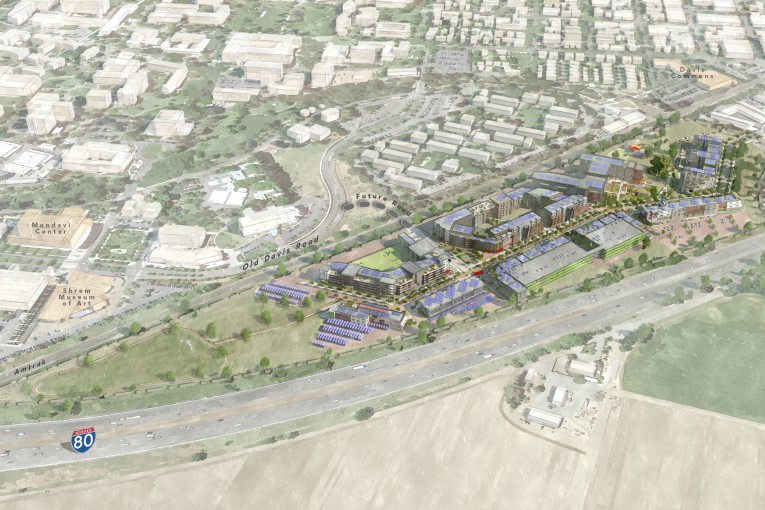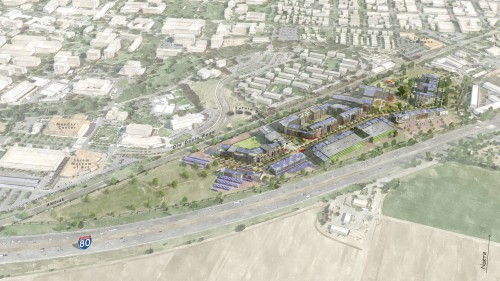

This week, the city released the Final Environmental Impact Report on Nishi (you can read it here). However, the questions going forward have concerned a number of critical issues facing the site, which is enticing to many due to its location next to the university and within walking distance from downtown.
The project, on 47 acres of land, provides the city with about 650 housing units along with a possible hotel and 325,000 square feet of research and development space.
However, along with the allure of the location comes concerns. Currently, the university has not approved a university access point for the project – a feature that the majority on council last month said was a necessity. Moreover, there are concerns about additional road impacts on the already-congested Richards Boulevard.
Finally, Thomas Cahill and others are concerned about air quality issues, as the site is nestled between I-80 on the south and the Union Pacific train tracks on the north.
On Friday, developer Tim Ruff told the Vanguard that he was committing to several features before the project could go forward. He said the intent of his commitments were “to provide clarity and focus to the discussion moving forward.”
First, he said that he is committed to “two access points.” That means both a university access point and one on West Olive Drive. Furthermore, he said there would be “NO project unless (the University of California) Regents approve UCD access for cars-bikes and pedestrians.”
Toward concerns about the already-impacted Richards Blvd. – an area the council is looking to tackle, as it stands now – Mr. Ruff stated that there would be “NO occupancy until Richards Corridor improvements (interchange) are complete.”
The economic analysis provided by EPS (Economic & planning Systems) showed a $78,000 net deficit. Last month, Tim Ruff offered that, with the hotel, the project can move into the fiscally positive territory.
“We are committed to building a project that will bring the most benefits to our community through this collaborative planning process,” said Tim Ruff, who is a managing partner of the Nishi Gateway project, “In addition to the fiscal benefits to the City, Nishi will provide a 30-year revenue stream for Davis Joint Unified School District. This ongoing multi-million dollar revenue stream to the city and our public schools will help pay for the quality of life we all enjoy in this great community.”
Now, he says he is committed to making the project end up as a net fiscal positive, “with or without” the hotel proposal.
While the Vanguard has pushed for either a carless project or a greatly reduced number of parking spots, at this point the developer is offering a “10 percent reduction in parking off current plan,” which would result in “192 fewer parking spaces.”
In hopes that vehicle flow in and out of the site would be reduced, Mr. Ruff is offering to meter the peak hour vehicle trips and provide a cap for those living and working on the site. This is part of the Sustainability Implementation Plan (SIP) where they suggest the need to “set a trip cap for program monitoring purposes. The trip cap will be a maximum of 415 PM peak hour vehicle trips from the Nishi development, which is a 10 percent reduction in project trip generation.”
They add in the SIP: “The Management Entity for the Nishi development will collect annual counts during the weekday AM and PM peak hours at the project driveways to monitor the project’s vehicle trip generation. Should the peak hour trip cap be exceeded, additional TDM measures shall be implemented by the project management entity to reduce peak hour vehicle trips. These additional measures may include transit service and/or subsidizing existing transit service, constructing bicycle facilities, and/or making multi-modal street improvements to be selected by the City of Davis from the list of area-wide improvements identified in the City’s CIP.”
On the sustainability front, they are pledging a 4.9 megawatt photovoltaic cell. In the SIP they note, “By employing the best practices in energy efficiency described previously in this report, the Nishi development is predicted to save over 4,700 megawatt hours (MWh) of electricity and 75,000 therms of natural gas annually relative to the business-as-usual scenario. After taking into account electricity production from the 4.9 MW PV capacity… estimated net electricity savings for the Nishi development are almost 13,000 MWh and 82 percent TDV savings.”
They are offering a $14.7 million investment in greenhouse gas (GHG) reduction goals at $3 per watt estimated.
Mr. Ruff commits to the full implementation of the Comprehensive Sustainability Implementation Plan, which includes provisions for both performance and monitoring.
Does this proposal go far enough? As the Vanguard has reported, council has been extremely supportive overall of the project, but they have concerns about access and Richards Blvd., therefore last month the council expressed that, without an access point onto campus and the ability to deal with traffic on Richards, there would be no project.
Mayor Pro Tem Robb Davis stated it clearly, “I will not vote to put this on the ballot in June without conditions related to access. The cleanest way is to say no undercrossing at the railroad – no project. No improvements to Richards – no project.”
However, like his colleagues, he said, “I’m willing to see what we can come up with in terms of this other way that may allow certain things to go forward in phased way, but no further. With the idea that the actual, that’s on the table in front of us, cannot be developed without the second crossing.”
Councilmember Brett Lee said, “I’m a little bit uncomfortable with this notion that we’re supportive of the June ballot and asking staff to come back and address some concerns.” He said that staff could come back with the proposal that he is either supportive or not supportive of, depending on the specifics.
He said that, while he was in generally in favor of a June ballot for this project, he wants to see specific things before he will support that project. “The actual specifics make a lot of difference,” he said. “Even with the second crossing,” he said, “there are many shapes and sizes of this project that would not be acceptable to me.”
Councilmember Lucas Frerichs added that the issues of access have been the key topic since this project was first discussed. “Access to this site,” he said, “that is the linchpin across which the success or failure of the site hinges upon. For me, particularly, the proposed grade-separated crossing, the tunnel through the university, having that second access point, is absolutely essential.”
Councilmember Rochelle Swanson also agreed, saying that “that access point with the university, that’s essential for the success of the project and it’s also essential for the success of the applicant going through and moving it forward.”
—David M. Greenwald reporting

10 percent parking reduction is a non-starter. Why not go to 50 percent? driving is way down among milennials?
Parking planning should have some basis in sound planning principles. There are standards for how many spaces per resident in various housing configurations. Parking areas in a development provide for overnight parking for residents, for visitors, and for deliveries. If the parking area is insufficient it actually can create safety issues. It may be true that “driving is way down among milennials” but that does not lead automatically to a 50% reduction in parking.
https://www.planning.org/pas/at60/report214.htm
As opposed to this:
https://www.itdp.org/planning-around-transit-the-case-for-less-parking-and-more-mobility-in-sao-paulo/
Is the university the only one who has to agree to auto-pedestrian-bicycle access to the campus from the Nishi property, or does the railroad need to agree, too, because the train tracks are between Nishi and the campus?
UP needs to “permit” but it is arguable if they can say “no”… they can greatly influence “how”… given eminent domain, and the opportunity to abandon the existing at-grade crossing @ Arboretum Drive, strongly doubt that UP would/could say “no”… but might well be ‘slow as molasses in January’…
I’m told the railroad has already agreed to it.
Perhaps in theory [which I posited], but strongly question whether your “source” understands the procedural timelines to make it “a happening thing” that are involved… I’ll bet 2-3 years from the submittal of an actual application. Requires draft construction drawings to even start the process.
Could you elaborate on that timeline pierce?
It’s not really a source:
Based on what I understand was the actual timeline to put the bike/ped crossing in behind Davis Commons.
Hope y’all can note that the letter posted confirms everything I said, except for timing, which is not discussed in the letter…
“I’m told the railroad has already agreed to it.” @ David Greenwald
I concur with hpierce. This letter is not evidence that the railroad has already agreed to it.
There’s a huge chasm between a a UPRR Manager that “supports the concept” and a formal agreement between the four parties to build an underpass.
Has the City followed through with even the most basic preliminary steps to move this forward (the letter is dated over 2 1/2 years ago)?
Have they submitted a copy of the Preliminary Engineering Authorization Letter?
Have they submitted a copy of the Preliminary Plans?
The evidence that this underpass is real is pretty thin.
More to the point, what mechanisms exist to turn developer promises into legally binding commitments? Are Tim’s press statements backed by a formal request to incorporate developer responsibility for timely completion of the RR undercrossing and Richards Boulevard improvements into the Measure R baseline features list?
Tim answered the question for me: the inclusion of the RR undercrossing and Richards improvements are now part of the baseline features, and were presented to the Planning Commission as such.
I spent some time talking with Chris Granger of Cool Davis, who spoke in public comment at Wednesday’s Planning Commission workshop on Wednesday. Her observations were very similar to Jim’s . . . with her focus being on carbon footprint and greenhouse gases. She is impressed with the conceptual commitments that the Nishi Gateway team has stepped forward with; however, those conceptual commitments need to be taken to the next step before the Development Agreement. Chris described that next as a fully fleshed out implementation plan for each of the conceptual commitments. That is her version of what Jim has described as “developer responsibility for timely completion.”
I misspoke … there are more than 4 parties that have to be in agreement to get the UPRR undercrossing built:
Union Pacific
The developers
Yolo County
UC Davis
UC Regents
UCOP
City of Davis
The project’s financial backers and lenders
The appropriate State and Federal regulators
If (1) the voters approve the project before there are sufficient formal agreements/contracts between all these parties, and (2) the process breaks down (leaving the developers are unable to perform) – then the City will find itself in uncharted territory. It’s an interesting legal question. The public should understand the risks in advance so that there is no whining if Measure R itself winds up getting adjudicated.
Promises from the City and the developers aren’t sufficient. The Development Agreement, in particular, can be amended at any time by the parties without voter approval.